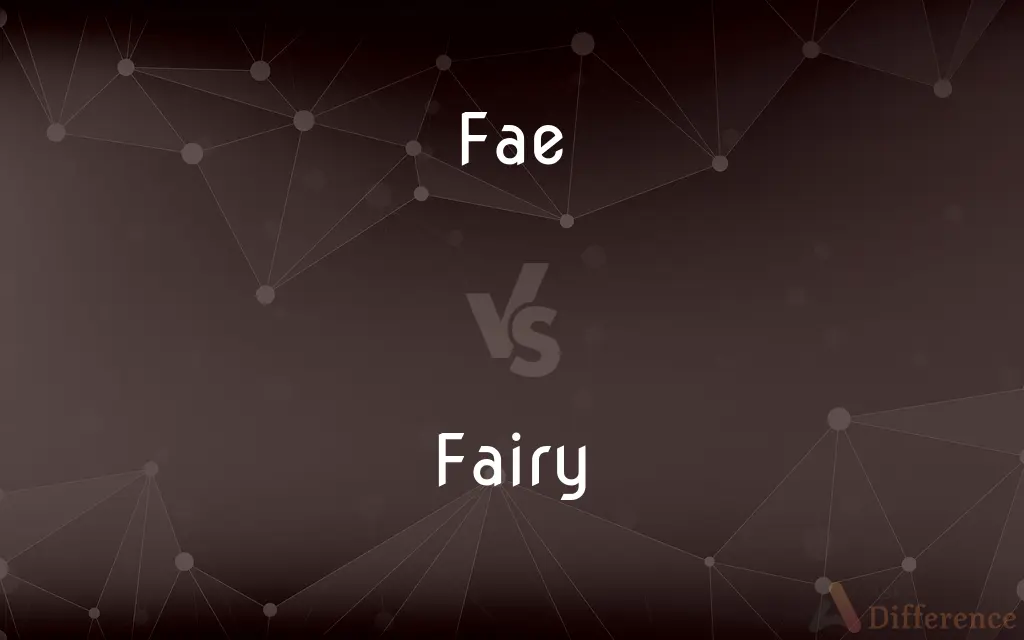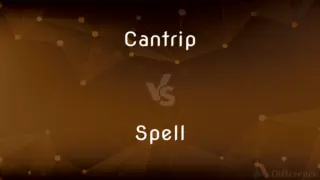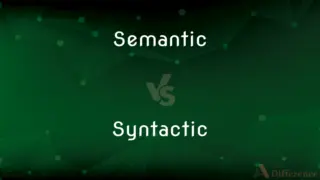Fae vs. Fairy — What's the Difference?
By Fiza Rafique & Urooj Arif — Updated on March 17, 2024
Fae is a broader term for mythical beings with magical powers, while fairies are specific creatures within the fae realm, often depicted with wings and a connection to nature.

Difference Between Fae and Fairy
Table of Contents
ADVERTISEMENT
Key Differences
Fae encompasses a wide range of mythical, magical beings across various cultures and folklore, characterized by their mystical powers and connections to nature or other realms. On the other hand, fairies are often envisioned as a specific subset of the fae, typically portrayed as diminutive, winged creatures with a close association with natural elements and a penchant for mischief or benevolence.
While the term "fae" suggests a broad category that can include elves, goblins, and other supernatural entities, fairies are more narrowly defined, often depicted in literature and art as having human-like appearances and the ability to fly, thanks to their delicate wings. In contrast, other members of the fae might not share these specific characteristics.
The origins of the fae can be traced back to various mythologies and folklore, where they were revered, feared, or worshipped as deities, spirits, or ancestors. Fairies, however, have become especially popular in Western folklore, often romanticized in Victorian literature and art, highlighting their playful nature and interaction with the human world.
Cultural perceptions of fae vary widely, with some traditions viewing them as benevolent guides or protectors of nature, while others see them as tricksters or even malevolent beings. Fairies, particularly in modern interpretations, are generally seen in a more positive light, embodying the enchanting and whimsical aspects of nature.
Despite these differences, both fae and fairies are integral to the rich tapestry of folklore and mythology, capturing the human imagination with their mystery, magic, and connection to the natural world. Their stories continue to inspire a wide range of artistic and literary works, from ancient tales to contemporary fantasy fiction.
ADVERTISEMENT
Comparison Chart
Definition
A broad category of mythical beings with magical powers
Specific creatures within the fae realm, often winged and connected to nature
Examples
Elves, goblins, sprites, nymphs
Tinker Bell, the Tooth Fairy
Characteristics
Can vary widely from benevolent to malevolent
Often depicted as playful, benevolent, and nature-bound
Origins
Rooted in various global mythologies and folklore
Primarily popularized in Western folklore
Cultural Perception
Viewed differently across cultures; can be revered or feared
Generally seen as whimsical and enchanting
Compare with Definitions
Fae
Encompasses a wide range of mythical beings.
The ancient woods were said to be home to various fae.
Fairy
A type of fae, often depicted with wings.
The garden was adorned with statues of fairies.
Fae
Rooted in global mythologies.
The fae in the tale were inspired by Celtic mythology.
Fairy
Closely associated with natural elements.
The fairy was guardian of the flower meadow.
Fae
Range from benevolent to malevolent.
The fae could either aid or hinder travelers, depending on their nature.
Fairy
Popularized in Victorian literature.
Victorian poems often featured fairies dancing in moonlit glades.
Fae
Possess diverse magical abilities.
The fae used their magic to protect the forest.
Fairy
Generally seen as enchanting and good.
Children's stories depicted the fairy as a kind and helpful being.
Fae
Holds significant cultural and spiritual importance.
In some cultures, rituals are performed to appease the fae.
Fairy
Known for playful and benevolent acts.
The fairy left a trail of glittering dust in her wake.
Fae
Alternative spelling of fey
Fairy
A fairy (also fay, fae, fey, fair folk, or faerie) is a type of mythical being or legendary creature found in the folklore of multiple European cultures (including Celtic, Slavic, German, English, and French folklore), a form of spirit, often described as metaphysical, supernatural, or preternatural. Myths and stories about fairies do not have a single origin, but are rather a collection of folk beliefs from disparate sources.
Fae
Alternative spelling of fey
Fairy
A small imaginary being of human form that has magical powers, especially a female one
Fairy gold
She believed she had had fairies at the bottom of her garden
Fae
A gender-neutral third-person singular subject pronoun, equivalent to singular he and she.}}
Fairy
A Central and South American hummingbird with a green back and long tail.
Fae
A device consisting of a container of fuel and two explosive charges; the first charge bursts open the fuel container at a predetermined height and spreads the fuel in a cloud that mixes with atmospheric oxygen; the second charge detonates the cloud which creates an enormous blast wave and incinerates whatever is below
Fairy
An imaginary being in human form, depicted as clever, mischievous, and possessing magical powers.
Fairy
Offensive Slang Used as a disparaging term for a gay man.
Fairy
The realm of faerie; enchantment, illusion.
Fairy
A mythical being with magical powers, known in many sizes and descriptions, although often depicted in modern illustrations only as a small sprite with gauze-like wings, and revered in some modern forms of paganism.
Fairy
An enchantress, or creature of overpowering charm.
Fairy
A member of two species of hummingbird in the genus Heliothryx.
Fairy
A legendary Chinese immortal.
Fairy
Like a fairy; fanciful, whimsical, delicate.
Fairy
Enchantment; illusion.
The God of her has made an end,And fro this worlde's fairyHath taken her into company.
Fairy
The country of the fays; land of illusions.
He [Arthur] is a king y-crowned in Fairy.
Fairy
An imaginary supernatural being or spirit, supposed to assume a human form (usually diminutive), either male or female, and to meddle for good or evil in the affairs of mankind; a fay. See Elf, and Demon.
The fourth kind of spirit [is] called the Fairy.
And now about the caldron sing,Like elves and fairies in a ring.
Fairy
An enchantress.
No goblin or swart fairy of the mineHath hurtful power over true virginity.
Fairy
Of or pertaining to fairies.
Fairy
Given by fairies; as, fairy money.
Fairy
Small, human in form, playful, having magical powers
Common Curiosities
Are all fairies considered fae?
Yes, all fairies are considered a subset of the fae, but not all fae are fairies.
Can fae be harmful?
Depending on the folklore, some fae are depicted as harmful or malevolent, while others are helpful or protective.
Are fae and fairies real?
Fae and fairies are mythical beings from folklore and mythology, with no evidence to support their physical existence.
How can you protect yourself from harmful fae?
Folklore suggests various protections, such as iron, salt, or specific herbs, to ward off harmful fae.
Can fae and fairies change their appearance?
Some stories and mythologies suggest that fae and fairies have the ability to shape-shift or change their appearance.
Do fae and fairies have magical powers?
Yes, both are often attributed with magical powers or abilities in folklore.
How do fae interact with humans?
Interactions can vary greatly, from benevolent guidance to trickery or even hostility, depending on the tale and the nature of the fae.
Do all cultures have fae or fairies in their folklore?
Many cultures have myths of magical or supernatural beings that could be considered similar to fae or fairies, though they may vary greatly.
How are fae and fairies depicted in art?
Fae and fairies have been depicted in various forms of art, from ancient carvings to modern digital illustrations, often emphasizing their connection to magic and nature.
Do fairies always have wings?
In many modern depictions, fairies have wings, but in some older folklore, they may not necessarily be winged.
Are there male fairies?
Yes, there are male fairies, though popular culture often focuses more on female fairies.
Can fae and fairies be part of religious beliefs?
In some cultures, fae and fairies are intertwined with spiritual or religious beliefs and practices.
Have perceptions of fae and fairies changed over time?
Yes, perceptions and depictions of fae and fairies have evolved over time, influenced by cultural changes, literature, and media.
Are there modern stories about fae and fairies?
Yes, fae and fairies continue to be popular subjects in modern fantasy literature, films, and other media.
Are fae and fairies always associated with nature?
While often connected to natural elements, not all fae or fairies are explicitly linked to nature in every story or myth.
Share Your Discovery

Previous Comparison
Cantrip vs. Spell
Next Comparison
Semantic vs. SyntacticAuthor Spotlight
Written by
Fiza RafiqueFiza Rafique is a skilled content writer at AskDifference.com, where she meticulously refines and enhances written pieces. Drawing from her vast editorial expertise, Fiza ensures clarity, accuracy, and precision in every article. Passionate about language, she continually seeks to elevate the quality of content for readers worldwide.
Co-written by
Urooj ArifUrooj is a skilled content writer at Ask Difference, known for her exceptional ability to simplify complex topics into engaging and informative content. With a passion for research and a flair for clear, concise writing, she consistently delivers articles that resonate with our diverse audience.
















































